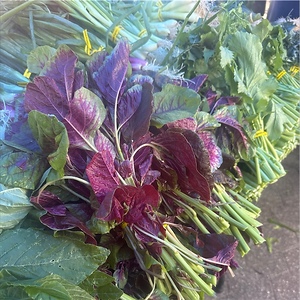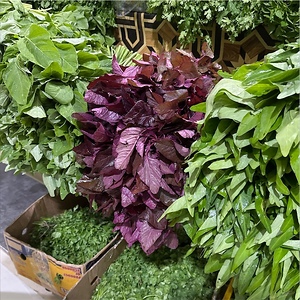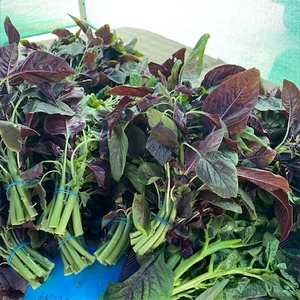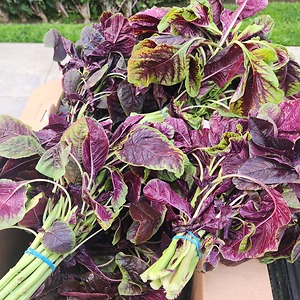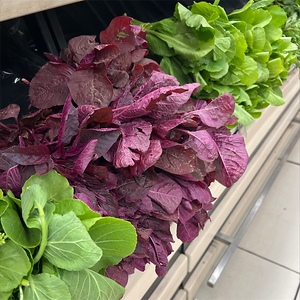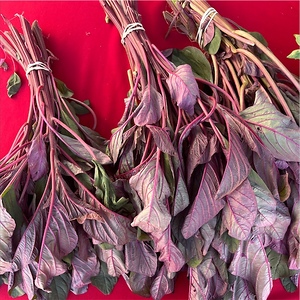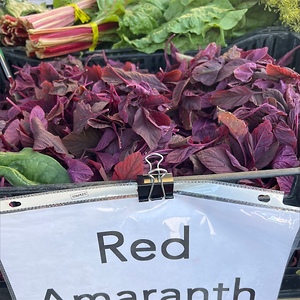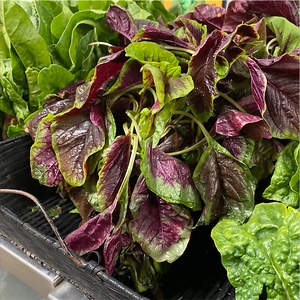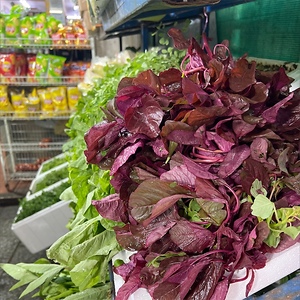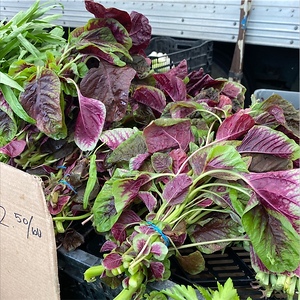


Red Amaranth
Estimated Inventory, bunch : 0
Description/Taste
Red amaranth is a leafy plant known for its colorful, elliptical-shaped leaves. These leaves feature rounded to pointed tips, with a central purple stem and diagonal veins extending outward from the stem. Some Red amaranth varieties are entirely maroon-purple in color while others have a deep maroon center with streaks of red, purple, and green. Red amaranth leaves have a soft, tender texture, with a slightly wrinkled appearance and a delicate, flimsy structure. This plant also produces long, feathery purple, magenta, or red flowers from the central stalk packed with edible black seeds. The flower buds can be consumed but once they mature and become bushy, are not palatable and should be avoided. Young Red amaranth leaves are slightly astringent when raw with a mildly nutty and spinach-like taste.
Seasons/Availability
Red Amaranth leaves are available in the spring, summer, and fall.
Current Facts
Red amaranth is botanically known as Amaranthus cruentus and belongs to the Amaranthaceae family, which also includes beets, chard, spinach, and quinoa. The name amaranth comes from the Greek word amarantos, which means never-fading or one that does not wither, alluding to the plants' bushy flowers that retain their color long after they're harvested. Red amaranth leaves are often consumed as a green vegetable in Asian cultures and are known as Chinese spinach or Chaulai leaves in India. This heirloom grows on plants that can reach heights of 2 to 3.5 meters and is often used ornamentally for its striking flowers. Varieties like Love Lies Bleeding amaranth may be utilized to produce red dyes. In culinary use, Red amaranth is valued for its edible seeds and leafy greens.
Nutritional Value
Red amaranth contains vitamin A, which supports eye health and skin repair. The vitamin C found in this variety acts as a powerful antioxidant, boosting immunity and enhancing iron absorption. The B vitamins in Red amaranth play a crucial role in energy metabolism and nervous system function. This plant is a source of calcium and potassium, contributing to bone health, heart function, and maintaining healthy blood pressure levels. The iron in Red amaranth is vital for red blood cell production and preventing anemia while the zinc supports wound healing. Its copper and manganese content plays a role in enzyme function, antioxidant defense, and bone formation. When cooked, Red amaranth offers essential minerals that promote overall health. Among these minerals, magnesium plays a crucial role in muscle function and energy production while phosphorus supports healthy bones and teeth. The zinc and copper in this plant boost immune function and iron metabolism. Red amaranth may contain potentially harmful tannins, oxalates, saponins, and protease inhibitors. To prevent exposure to these compounds, the leaves should be cooked before consumption.
Applications
Red amaranth leaves may be consumed raw, cooked, stewed, or braised, similarly to chard, beet greens, and spinach. The younger leaves are mild and tender while the more mature leaves are slightly fibrous and develop a bitter flavor. When the edible blossoms appear, it usually indicates that the leaves are past their prime for eating. Add Red amaranth greens to salads and soups or briefly sauté them with oil. They can be chopped into curries, stir-fries, smoothies, rice dishes, meatloaf, and tomato sauces. Red amaranth seeds may be sprinkled into sandwiches for added texture or incorporated into a traditional Mexican porridge called atole. They are also used in a sweet, crispy candy called alegría that's made with nuts and chocolate. Complimentary flavors include bacon, ham, poultry, anchovies, garlic, onions, sesame seeds, soy sauce, potatoes, coconut, honey, maple syrup, lemon, mushrooms, oregano, dill, cumin, goat cheese, parmesan, ricotta, mustard, walnuts, almonds, cherry tomatoes, cucumbers, pickles, berries, bananas, and almond milk. Red amaranth leaves can be refrigerated for 3 to 5 days. To preserve the seeds, they should be frozen or stored in an airtight container.
Ethnic/Cultural Info
Amaranth has been consumed as a grain by the indigenous people of Mesoamerica for 6,000 to 8,000 years. It was a major food source for the Ancient Aztecs and was also used in their ceremonial religious practices. The grains were combined with honey and formed into the likeness of a deity, worshiped, and eaten in communal feasts. When the Spanish conquistadors attempted to convert the native populations to Christianity in the sixteenth century, they forbade these festivals surrounding Amaranth and punished those in possession of it.
Geography/History
The amaranth species from which Red amaranth originated is native to Central America and has been cultivated along the Andean regions of Bolivia, Ecuador, Argentina, and Peru for thousands of years. This species was a significant part of the local diet when Europeans introduced Red amaranth to North America, where it quickly became naturalized. Red amaranth grows in temperate, tropical, and subtropical climates with hot, dry weather during the summer. It’s often seen growing wild as weeds in fields, along roadsides, and in uncultivated lands. Red amaranth is popularly cultivated commercially and in home gardens in Southeast Asia, sub-Saharan Africa, India, Central and South America, Vietnam, and China. It’s more commonly purchased as seeds to grow into a plant rather than bought as leaves from stores or farmers' markets.
Recipe Ideas
Recipes that include Red Amaranth. One
| Happy & Harried |
|
Indian Cottage Cheese with Greens Curry |



